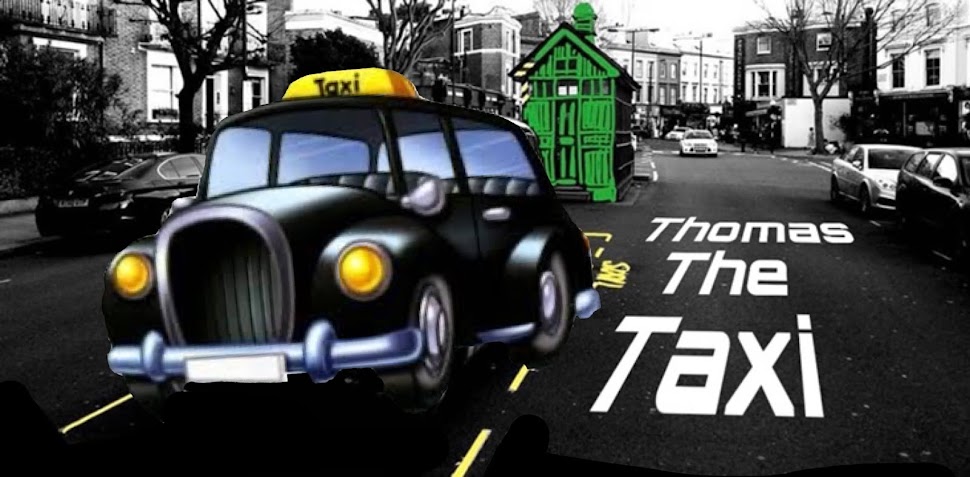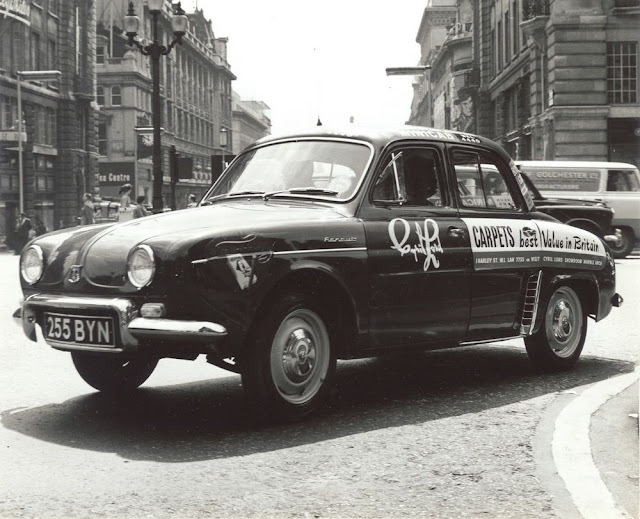On the 6th March this year, London’s minicabs were officially 60 years old...but in wasn’t mentioned anywhere in the media...the true conception and date never is. The BBC have always missed the fact that modern day minicab was an invention of Tom Sylvester and his company (Carline cars). Yet the Beeb always give the honour to Michael Gotlar and his empire of Renault Dolphins at Welbeck motors
A basic form or Private Hire vehicle, actually go back century’s when a more basic unlicensed horse drawn coach along with coachman, could be hired from livery stables.
When in 1897 the first motorised Taxis arrived on London streets in the form of the the Bersey Electric Cab the Bersey Electric private hire vehicle appeared alongside and could be hired from an office at a cheaper rate than the Taxi.
With the new area of the French-built Prunel Petrol Taxis (first appearing in 1903), certain garages hired out similar vehicles as a hire car with driver. But this wasn’t necessarily for a single use journey.
Although available (albeit in very small numbers) in the background, they were not deemed popular and were uneconomical to run as a business and so disappeared for many years giving the Taxi trade no competition.
So contra to BBC belief, who to this day still get it wrong, Micheal Gotla’s Renault Dolphins of Welbeck Motors fame were not the first private hire vehicles. They were beaten to the off 18 weeks earlier by Carline Cars.
Welbeck weren’t even the first company to facilitate their drivers with a radio circuit, although they were the first to have adverts plaster all over their vehicles, which at the time was seen as a clear challenge to the law which denied commercial vehicles access through London’s Parks including the Mall.
This didn’t seem to bothered Gotla who instructed his liveried vehicles to go through the parks regardless. It’s alleged that Gotla had lobbied Harold McMillan's government to put pressure on the Royal Parks Police to go easy on his cars....in much the same way as Uber lobbied David Cameron to put pressure on Mayor Boris Johnson.....history repeating its self!
So...who invented minicabs?
The First Modern Era Minicabs.
At the beginning of 1961, Tom Sylvester found a loophole in the 1869 Carriage Act.
Although ‘plying for hire’ was and still is restricted to London Hackney Cabs, with a telephone call to his cab office (Carline Cabs), he believed you could circumvent the Act. Sylvester declared, his drivers were not plying for hire, they were simply responding to a telephone call.
So...starting on 6th March 1961 his small fleet of 12 Ford Anglia 2-door 105E’s (Minicabs) went into business.
Hardly posing a threat to the thousands of black cabs plying for hire on London’s streets, incredibly, in the first week of operations Toms little Anglia’s carried over 500 passengers.
You could say that in the modern era, the little Ford Anglia was actually the first “minicab”....although within months, Sylvester’s Carline cars introduced the eye catching black and white Fiat 600 Multiplas.
However, it was Michael Gotla who later in the same year, introduced private hire vehicles on a more commercial scale with a fleet of 200 French built Renault Dolphins. Gotla had a dream of increasing his fleet to 2000 vehicles within just a few years.
Welbeck were able to launch their new business with speed because they had been operating a successful self drive Austin A40 car hire service, from their base at 117-119 Crawford Street since the late 40's. Welbeck Motors car hire were mentioned many times in articles and books in 1951, because of their connection to the disappearance of Burgess and McLean. Welbeck were thought to be the service of choice for the Cambridge 5 and although it’s been alleged, there has been no proven link between Gotla and the spy-ring.
Also we are reliably informed that Welbeck motors and the so called cab war that followed, were the inspiration behind the comedy 'Carry On Cabbie'.
See the BBC’s account of what the trade thought about Gotla, on their Facebook page
This is a must watch, extremely interesting video from the BBC archives. It shows how Mr G (as Gotal liked to be known) was planning to circumnavigate the legislation on plying for higher.
Also, a strategy to vastly under cut the Taxi trades prices, especial on longer journeys.
Many in our trade believe that plying for hire should have been defined back in the sixties when private hire started to take advantage of the flaws in the legislation.....flaws that are still being exploited and affecting our trade today.
Back in 1961, Welbeck Motors was a well-established London motor trader and its MD Michael Gotla identified a loophole in the law concerning taxi-cabs.
The legislation of the day stated that “Private Hire Car Services” could operate if they were “pre-booked”. A minicab would not be allowed to ply for hire, but what if a would-be customer telephoned Welbeck or hailed one and his or her order was then radioed to the office…
And so Gotla acquired the financial backing for an initial fleet of 200 Dauphines. His choice of Minicab was partially dictated by his need for a cheap four-door saloon and, as Motor Sport pointed out in August 1961:
B.M.C. (who make real taxi-cabs) were not in the least interested in Mr. Gotla's project and that Ford couldn't decide whether or not they wanted to help. But it is no secret that Renault were willing to supply Dauphines at a substantially reduced price – Welbeck collect them on their own two-tier transporter.
The Renaults were fitted with the optional four-speed gearbox for reasons of stability and converted to a 12-volt electrical system to accommodate the Pye radio system and the meter. The cabs were to be in service 24-hours per day, and Welbeck carried out servicing in-house.
Fares were one shilling per mile, and Gotla claimed that if three people shared a Renault, it was almost as cheap to go to work by minicab as it was by public transport.
However, given the size of a Dauphine, they would have to be very close friends, especially as the meter occupied part of the front of the cabin. They would also need to carry a limited amount of luggage that would fit into the seven cubic feet boot; the Welbeck cars were not fitted with a roof rack.
The taxi trade was cynical about the ability of a standard production car being able to carry out the duties of a purpose-built vehicle, and there were further mutterings about Welbeck daring to use a “French car”. In fact, the Dauphine was a well-established car with British motorists of that time.
By 1960 Renault had sold one million examples worldwide and until 1961 UK market versions were assembled from CKD kits in the company’s Acton plant. There were also some hilarious sales campaigns promising ‘a penny farthing a mile, and you travel in style’ in a car where ‘the built-in heater couldn’t be neater!’:
One major selling point for the Minicabs was that they operated in the suburbs and Michael Gotla argued to The Guardian that:
“You have got to have a taxi system for Greater London. The present system really only caters for Central London. London is the most under-taxied capital in the world. The reason the trade doesn’t think it is under-taxied is that its stamping ground is only central London.”
As for recruitment, any would-be driver with two years’ experience of accident-free motoring in the capital was urged to call WELbeck 4440. A successful applicant was allowed to keep their tips, and a further perk was a stylish beige corduroy suit. However, the general of “Gotla’s Private Army” issued a stern warning:
“There is only one way to judge a Minicab driver and that is by his “take”. And if his “take” is not up to a certain mark, he is no good to us. And whether his “take” is not up to a certain mark because he is inefficient, a villain or just bone lazy, it really doesn’t matter…the sooner he leaves, the better.”
The reaction of the traditional cabbies, who had spent years acquiring “The Knowledge” was, almost inevitably, negative. After Gotla announced his minicab plans The Daily Herald on 8th March 1961 reported that ‘nearly 2,500 parked taxis caused a monster traffic jam in Central London last night while their drivers went to a two-hour protest meeting’.
When the service commenced on the 19th June, the same newspaper noted ‘At 3 pm today London’s 200 red Dauphine minicabs go into service against 9,000 taximen facing the biggest threat ever to their monopoly’.
They also noted that of the drivers ’15 of them are women’ - gosh and crikey. Gotla hoped that 500 Renaults would be in service by the end of the month, which would cost in the region of £560,000, and each Dauphine would need to earn £3 per shift for the operation to make a profit. One Welbeck minicab has a cameo appearance in the 1962 travelogue London for a Day, following a Leyland Titan double-decker.
Before the year was out the subsequent “Minicab Wars” on the streets attracted further publicity, not least after 37 cabbies were prosecuted in late 1961. The jolly voice over from this Movietone newsreel does not quite mask the wrath of certain cabbies although the line ‘we did get the views of several taxi drivers but decided it was wiser not to let you hear them’ infers the general attitude.
By November Michael Gotla had resigned from Welbeck Motors, and the final blow to the pioneer minicabs fell in 1962 when a court case ruled that they were indeed plying for hire. The “Army” was demobbed, and one story has it that many Dauphines was driven into quiet side streets and had their advertising regalia swiftly removed.






No comments:
Post a Comment